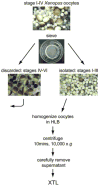Preparation of a highly active cell-free translation system from immature Xenopus laevis oocytes
- PMID: 20123127
- PMCID: PMC2868112
- DOI: 10.1016/j.ymeth.2010.01.031
Preparation of a highly active cell-free translation system from immature Xenopus laevis oocytes
Abstract
Understanding mechanisms of post-transcriptional control of gene expression has come under much scrutiny in recent years. A key question in this field is how the translation of specific mRNAs is activated or repressed both spatially and temporally in a given cell. In oocytes of the frog Xenopus laevis a number of mRNAs are localized early in oogenesis and subsequently translated at later stages. We have developed a highly active cell-free translation system from oocytes in the early stages of oogenesis that is applicable to the study of translation and translational control of both endogenous and exogenous mRNAs.
Figures



References
-
- Beckler GS, Thompson D, Van Oosbree T. In vitro translation using rabbit reticulocyte lysate. Methods Mol Biol. 1995;37:215–32. - PubMed
-
- Castagnetti S, Hentze MW, Ephrussi A, Gebauer F. Control of oskar mRNA translation by Bruno in a novel cell-free system from Drosophila ovaries. Development. 2000;127:1063–8. - PubMed
-
- Van Herwynen JF, Beckler GS. Translation using a wheat-germ extract. Methods Mol Biol. 1995;37:245–51. - PubMed
-
- Acker MG, Kolitz SE, Mitchell SF, Nanda JS, Lorsch JR. Reconstitution of yeast translation initiation. Methods Enzymol. 2007;430:111–45. - PubMed
-
- Pisarev AV, Unbehaun A, Hellen CU, Pestova TV. Assembly and analysis of eukaryotic translation initiation complexes. Methods Enzymol. 2007;430:147–77. - PubMed
Publication types
MeSH terms
Substances
Grants and funding
LinkOut - more resources
Full Text Sources

